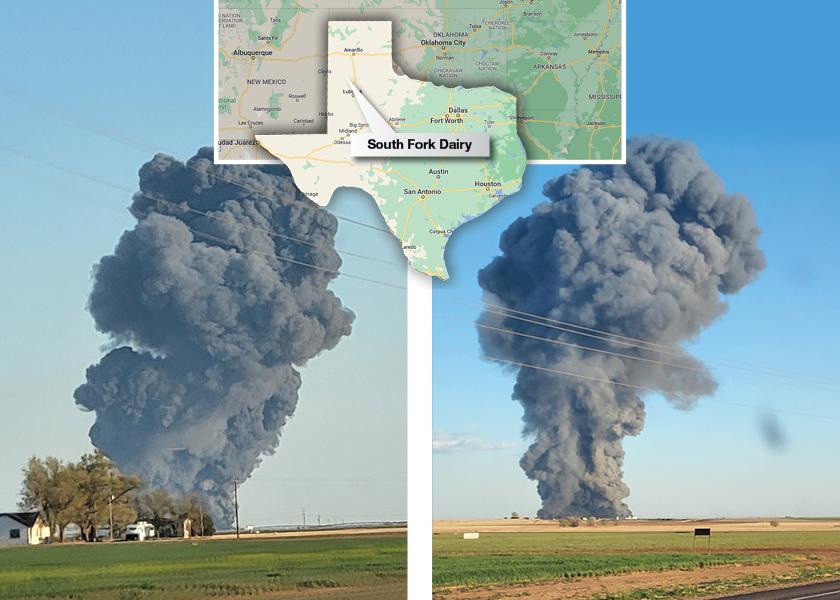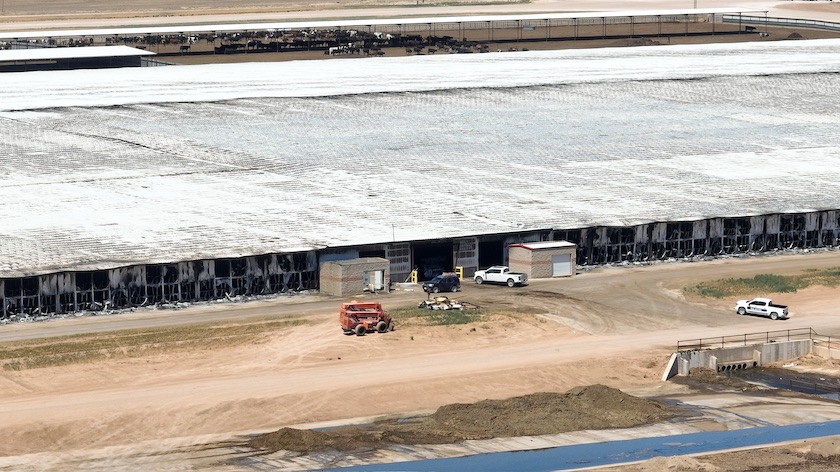What We Now Know About What Caused the Large Fire at a Texas Dairy Farm

The Texas Fire Marshal is investigating what caused the large fire that broke out at South Fork Dairy in Dimmitt, Texas, earlier this week. However, industry and dairy experts say current information from officials show it was an accident.
The reported explosion occurred at South Fork Dairy, which is located just southeast of Dimmitt. According to Castro County Sheriff Sal Rivera, the explosion occurred around 7:20 p.m. on Monday. There are unconfirmed reports of how many cows died from the fire, but officials believe it’s close to 18,000.
pic.twitter.com/Wq4lxyKg1G — Blake Bednarz (@BlakeBednarz) April 11, 2023
Dairy Management Inc. provided Farm Journal with a statement on behalf of the Texas dairy industry:
"We are deeply saddened for the family dairy, and everyone affected by the tragedy that occurred at South Fork Dairy farm. The cause of the fire is still under investigation, and we are deferring to the appropriate authorities to make that determination. Our thoughts are with the dairy family, their employees and local first responders, who are showing great resolve, courage and empathy while working through this tremendous loss."
Read More: Large Explosion and Fire Breaks Out at South Fork Dairy in Dimmitt, Texas Monday Night
Quickly after the news was first reported, rumors started to circulate about what caused the fire. Rivera says they speculate a "honey badger” - a machine which he described as a "vacuum that sucks the manure and water out” - may have been the cause. However, it seems the sheriff misspoke, as there’s no piece of equipment called a “honey badger” in dairy. Instead, it’s called a “honey vac.”
Rivera says the ongoing investigation will work to nail down what caused the fire to become so big and spread so quickly. He says initial thoughts are it was due to the insulation catching fire.
Based on the current information from officials, and aerial video that shows a charred roof evenly across the barn, Farm Journal reached out to several dairy producers, as well as insurance experts to see if the honey vac and insulation would cause such a large fire.
One source told Farm Journal the manure vacuum that sucks manure from cow lanes could have ignited the fire, as he’s had it happen before on their dairy farm. In their case, the fire didn’t spread.
The Cloud of Black Smoke
Additional sources say if the explosion was big enough to catch any part of non-fire-resistant insulation on fire, then it would spread like wildfire across the entire building, which covers nearly 40 acres. That would also explain why the fire didn’t last long, because once the insulation was all burned, then the fuel to the fire would also be gone. Insulation not being fireproof would also explain why the building had so much black smoke.
So, then what would cause the large mushroom cloud of black smoke? The building that caught fire was a recently built cross ventilated barn. Cross ventilated barns are typically large and have hundreds of fans to help control the climate with cow comfort in mind. With that many fans in a barn, it's possible once the fire spread so quickly, the hundreds of fans within the barn blew out the smoke, creating such a big smoke cloud that could be seen from miles away.
Railey Silhan, who lives in Morton, Texas, says the cloud of smoke from the explosion could be seen from her area, which is 80 miles southwest of Dimmitt.
Community Pours in With Support for Dairy Farm Family
The community is already coming together to support a dairy farm family that's now facing a loss on their family farm. Started just after the fire, a lunch/meal train was created to help support the family and crews on the scene. Local businesses and community members have already signed up, with two weeks’ worth of meals spoken for.
“They [Brand family] are a great family and customer, and today shows how we just help each other where we can. We live in a great community,” Elizabeth De Vries-Dykstra, who helped start the meal train, told Dairy Herd.








